All-on-four dental implants is a modern treatment that replaces all of your top, bottom, or top and bottom missing teeth with fixed prosthetic teeth that anchor onto several dental implants. Let's simplify that. First, you will receive four or more dental implants. Then your dentist makes a set of prosthetic teeth. The teeth are attached to the implants, typically via screws. You now have a set of permanent teeth that are locked in place. All-on-four treatment is the most economical way to replace all of your missing teeth with a fixed, non-removable prosthesis. Otherwise, you're stuck wearing removable teeth via full dentures. If you're looking to replace all of your teeth with a set of fixed teeth, then all-on-four dental implants might be the ideal solution for you.
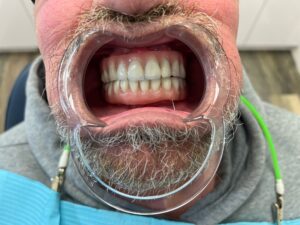
All-on-four dental implants give all of your missing teeth back
One of the main benefits of all-on-four teeth is how closely they resemble your natural teeth. All-on-4 teeth offer excellent chewing capability, superb aesthetics, and the feeling of having your original teeth back. You can finally chew a steak, talk without slurring, and smile at the world full of confidence! These are some of the reasons why people invest so much time and money into replacing their missing teeth with all-on-four dental implants.
Why choose all-on-four?
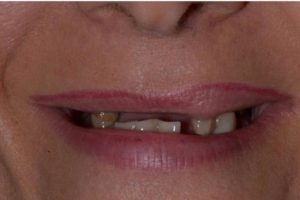
You must first remove all of your remaining teeth before starting all-on-four process
All-on-four teeth is a fixed prosthesis that attaches to several dental implants. The teeth you get are fixed and non-removable. This makes them much more comfortable than full dentures. A lot of patients who choose all-on-four have been struggling with wearing dentures for years. They find it difficult and painful to function comfortably with dentures. Denture wearers face a slew of problems with their false teeth, for example:
- Dentures offer poor chewing ability
- Dentures become looser and looser over time
- Due to their movement, dentures cause sore lesions inside the mouth
- Denture teeth wear out and they require regular maintenance and occasional redos
- Wearing dentures causes your jawbones to shrink at an accelerated rate
- Your facial muscles collapse and you develop more wrinkles
- The psychological impact of not having any teeth in your mouth can be profound
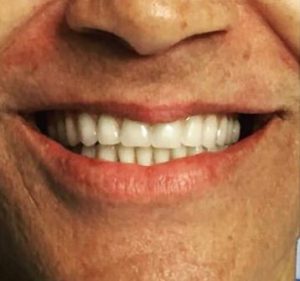
It's nearly impossible to tell all-on-four teeth apart from your natural teeth
Think of all-on-four as the easiest way to replace all of your missing teeth with permanent ones. All-on-four has simplified the process of replacing all of your teeth by minimizing the steps involved. Here's how:
- A minimal number of dental implants - All-on-four minimizes the number of implants used to restore your smile. Whereas full mouth implant restoration requires 8, 10, or even 12 dental implants to give you a full set of teeth, all-on-4 accomplishes the same results with just four dental implants.
- Bypassing complex bone grafting procedures - All-on-four bypasses the complex surgical procedures involved with full mouth dental implants. For example, full mouth dental implants require the placement of implants under the sinuses which requires sinus surgery. All-on-four bypasses this surgery by placing the implants in the anterior region under the nose. Full mouth dental implants require the palcement of implants in the posterior lower region where the Inferior Alveolar nerve is usually a problem. You may need extensive grafting to avoid damaging this nerve. Again, the all-on-four process bypasses this issue by skipping the posterior region and placing the dental implants in the anterior chin region.
- Simplified restorative process - Finally, all-on-four has simplified the restorative process. It is much simpler dealing with just four implants as opposed to a whole bunch of them as is the case with full mouth dental implants. As a result, all-on-four restoration typically takes one or two months. This is in stark contrast to full mouth dental implant restoration which can take close to a year, sometimes even several years to complete the process.
What are the steps involved in the all-on-four procedure?
Like most other implant treatments, the all-on-four process starts with surgery. Your dentist or oral surgeon will place four dental implants inside the mouth. If you are treating both the top and bottom jaws, your dentist will place four implants in the upper and four more in the lower jaw. Occasionally, your dentist may recommend using a 5th or 6th dental implant. The implants are all placed inside the jaw during your initial surgery. The healing process typically takes several months. Once healed, your dentist fabricates a full set of teeth that attaches to the implant screws. The teeth are typically made from porcelain or zirconia. In the end, you will have a set of teeth permanently locked onto the implant posts. These teeth function like natural teeth in terms of esthetics, chewing ability, etc. Here's a closer look at the all-on-four teeth process for those of you who are considering undergoing treatment:
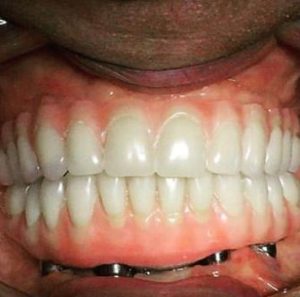
A demonstration of how the lower teeth are held in place by just four dental implants
All-on-Four Surgery: Teeth Extraction, Bone Grafting & Implant Placement
Let's start by discussing the tooth extraction process. To begin your all-on-four journey, you must first remove every tooth in the arch that's being treated. If there are any remaining teeth or tooth fragments, aka roots, they need to be removed at the time of surgery. This means that if you have one or two healthy teeth left, you must sacrifice these teeth and remove them. All-on-four replaces all of your teeth and you can not have any teeth left in the respective arch. If you do not want to remove these remaining teeth, you can discuss the option of placing individual implant crowns and implant bridges to fill in the gaps. However, if you want all-on-four teeth then you must remove the remaining teeth in that arch. The only exceptions are wisdom teeth and occasionally, a distally located molar tooth that sits behind the all-on-four prosthesis. Although rare, you may be able to leave these teeth alone, so long as your dentist is certain that the tooth will not interfere with the restoration process.
Next, let's discuss your dental implants. Your dentist must place a minimum of four dental implants inside your jawbone. The teeth extraction and implant placement may be performed during the same surgery if you're a candidate. This is referred to as immediate implant placement. You must meet certain strict criteria to qualify for immediate implant placement. This includes a lack of widespread infection, high-quality jawbone, and most importantly, being a non-smoker (or at least quitting smoking well in anticipation of your surgery). Immediate implant placement spares you from one extra surgery. It also allows your dentist to take advantage of the bleeding from teeth extraction to aid with the integration of the implant posts. Note that immediate placement is a difficult and technique-sensitive procedure. It requires a skilled and experienced oral surgeon, periodontist, or implant specialist. Not all dentists will offer you this option. Then again, not all patients qualify for immediate implant placement. If you do not qualify for immediate implant placement, you must remove your teeth and receive a bone graft. Then, you must wait several months for the bone graft to heal so that you can place the dental implants inside your mouth.
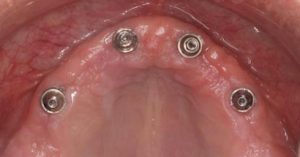
This is what your mouth will look like after all-on-four surgery
Lastly, let's discuss the bone grafting process. As previously mentioned, the bone grafting performed with all-on-four is not all that complicated. If you're receiving immediate implant placement, your dentist will sprinkle some graft material into the extraction sockets and around the implant screws. If you're doing the surgery in two steps then you will have your teeth removed and the sockets grafted. Afterward, you must wait several months for the graft material to heal before receiving your dental implants. Either way, there usually is no need for a sinus grafting procedure, nor for an autogenous bone graft. This is where your dentist cuts bone from one area and attaches it to another region. This is one of the major perks of all-on-four treatment, where it simply does not require these extensive (and expensive) grafting procedures.
Please note that the all-on-four surgery is very difficult. Surgery typically takes anywhere from two hours to six hours or even longer. Most patients undergoing all-on-four surgery elect to receive some type of sedation. Luckily, almost all dentists and oral surgeons who perform this treatment also offer sedation to get you through the surgery. IV sedation is the most common sedation option although oral conscious sedation and general anesthesia are also fantastic alternatives. Once sedated, you can relax and fall asleep while your dentist performs the surgery. A few hours later, you will wake up with the bad teeth gone and the good implants inside of your jaws. Now it is time to go home, take your antibiotics and painkillers, and get plenty of rest as you recover from a major surgery.
Final Prosthesis
Once you are done with the surgery, you must wait for the implants to join with the bone. This process is known as osseointegration. Typically, you need to wait several months, about 3 to 6 months, for the implant screws to properly osseointegrate. Sometimes you need one additional surgery to expose the implants and rebuild the gum tissue. This is known as second-stage surgery. If there are any complications, your dentist will address them over the next few months. Maybe one of your implants fails to integrate and you may have to redo it. there may be sharp pieces of bone that might require smoothing out. Some patients get lucky and they are ready for their teeth after just two to three months. Others need multiple corrective surgeries that take 9 to 12 months. Either way, your dentist or oral surgeon will guide you through the process to get you ready for your permanent teeth.
The all-on-four teeth are made from high-quality material designed to last a lifetime. This is in contrast to denture teeth which are made from fragile acrylic. Acrylic is prone to fracture and flattens with repeated use losing its chewing ability. We recommend that you stay away from acrylic for all-on-four dental implant teeth. There are two reliable options for permanent teeth with the all-on-four technique, which are porcelain and zirconia. These are both fantastic options and you can't go wrong with either one. Which one will you choose? A lot of this decision has to do with what your dentist prefers and what the lab is more comfortable with. Still, let's go ahead and compare the two options to give you a better idea of what you can expect:
Porcelain All-on-4 Teeth
Porcelain looks natural and closely resembles your natural teeth. However, porcelain is not strong enough to support your bite forces. Therefore, porcelain requires a metal bar or metal framework to strengthen it. Thankfully, the metal bar is completely hidden beneath the porcelain and invisible to the eye. This metal will not affect your smile and you will only show the beautiful porcelain teeth when smiling and talking. Here are the benefits of using porcelain to make all-on-four teeth:
- Porcelain looks very natural and absolutely beautiful
- Porcelain teeth are repairable just in case they chip or break
- Porcelain teeth are lightweight which makes them a great candidate to sit on just four dental implants
The disadvantages of using porcelain are as follows:
- Porcelain requires metal underneath it. While the metal is not visible, it does affect the shade and contrast of porcelain ever so slightly.
- There is a possibility that porcelain chips away from the metal, especially if your bite is not calibrated
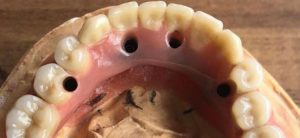
You can see the 4 access holes used to lock the prosthesis to the implants
Zirconia All-on-4 Teeth
The other option for all-on-four teeth is zirconia. Zirconia is stronger than porcelain, therefore there is no need to use metal. Zirconia teeth are extremely sturdy and even more durable than porcelain. However, zirconia is also much heavier than porcelain. Also, it is very difficult to repair zirconia in case of an accident. Luckily, zirconia teeth almost never break, but if they do, you usually have to remake the entire teeth. Here's a summary of the advantages of using zirconia for all-on-four teeth:
- Zirconia looks natural and beautiful
- There is no need to use any metal since zirconia is strong enough to handle your bite forces by itself
- Zirconia teeth are stronger than porcelain ones and are very unlikely to break
The disadvantages of zirconia teeth are as follows:
- Zirconia teeth are much heavier than porcelain. In fact, if you want a full set of teeth made from zirconia you may have to include a fifth or sixth implant in the design to handle this additional weight.
- While zirconia almost never breaks, if it does, it can not be repaired. You will have to either live with the chipped prosthesis or you have to redo the teeth.
In terms of looks and function, both zirconia and porcelain offer amazing and durable results. They are both nearly indistinguishable from your original teeth. The decision between the two typically comes down to you and your dentist's preference (and believe it or not, the laboratory's comfort level and skill set). Either way, you really can't go wrong with zirconia or porcelain. As long as your dentist places the implants in their proper positions, and makes you a well-fitting prosthesis to go along with these implants, you will love your new teeth!
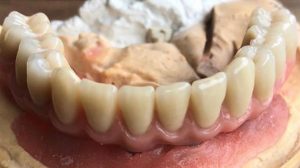
Example of lower all-on-four teeth made from white and pink-colored ceramic
Temporary teeth options during all-on-four treatment
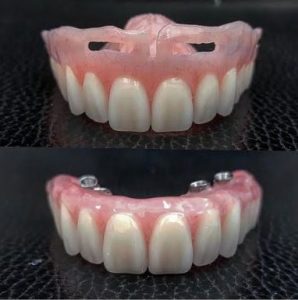
A comparison of full dentures (top) versus all-on-four teeth (bottom)
As you'd imagine, the all-on-four treatment is a long process. You must wear some sort of temporary teeth while your dental implants and extraction sockets heal. Temporary teeth give you something to chew with while your implants osseointegrate and solidify in their place. There are a few different temporary teeth options, which are:
Removable Denture
This is the most common option where you wear a denture on top of your dental implants. If you already have an existing denture that you like, your dentist should be able to modify the denture so that you can continue wearing them after surgery. Otherwise, you will require a new temporary denture, known as an immediate denture. Most dentists prepare your temporary denture in advance prior to the surgery. This way, you can receive your temporary denture right after the surgery and not have to walk around toothless.
Fixed Temporary Teeth
Occasionally, there might be an option to wear fixed temporary teeth after your implant surgery. Fixed temporary teeth stay in your mouth throughout the entire healing process and can not be removed. Making fixed temporaries is a time-consuming process that requires compliance. You also need to be a non-smoker and have sufficient jawbone to support the fixed teeth. Again, not everyone qualifies for fixed temporary teeth. Additionally, most dentists charge a substantial fee to make a fixed temporary. Regardless of which temporary option you choose the final outcome will be the same.
Get your smile back with all-on-four dental implants
All-on-four treatment is truly a life-changing experience. However, it is also an equally difficult and expensive treatment. It's important that you do your research to find a reliable, skilled dentist before getting started. Set aside a minimum of one year for your treatment although you might finish much sooner than that. Contact a dental implant specialist near you to learn more about all-on-four treatment and to see if you're a good candidate. Get your smile back, chew and talk with teeth that don't move, and live your best life full of confidence that comes with having permanent teeth in your mouth.
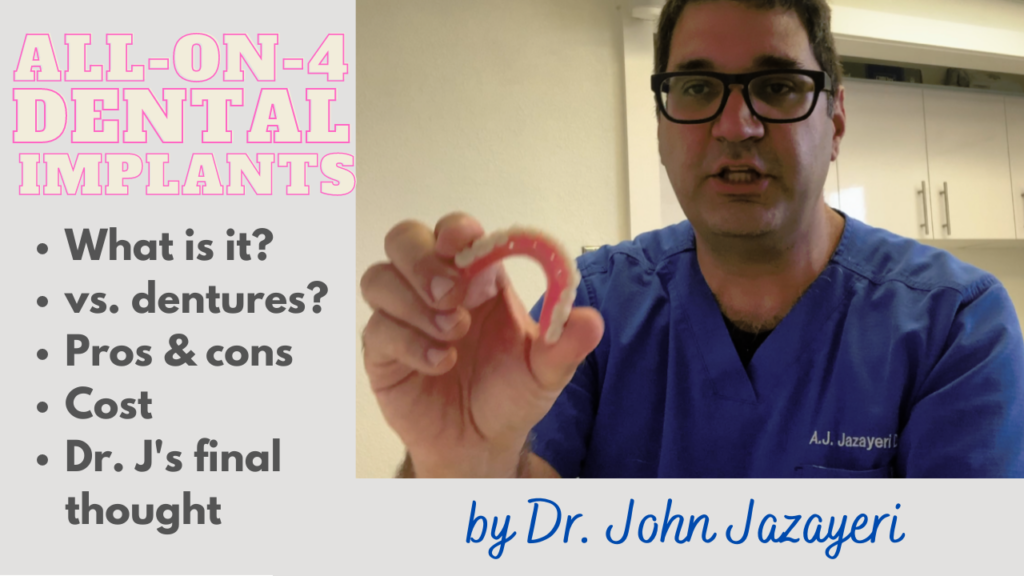
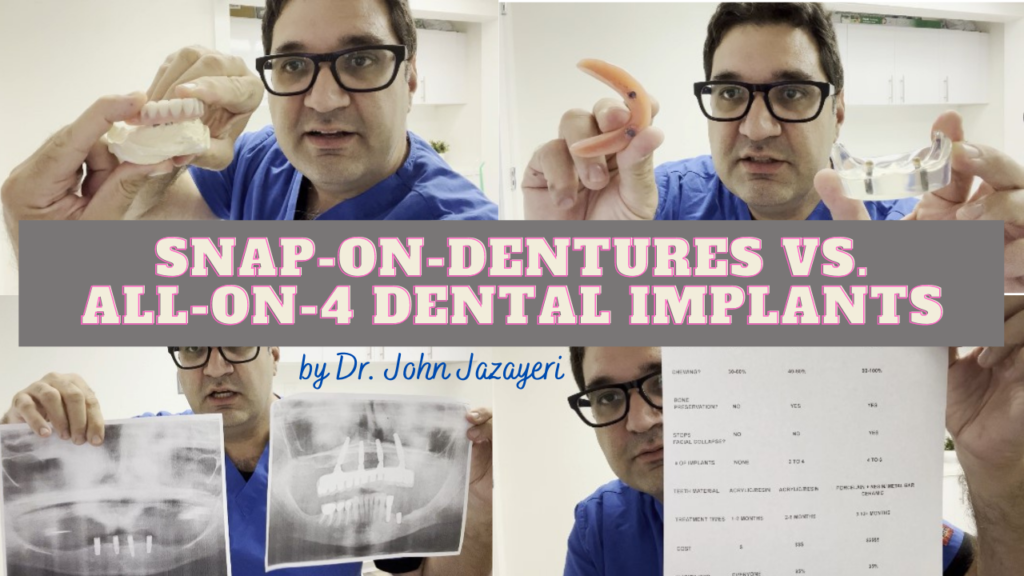
0 Comments